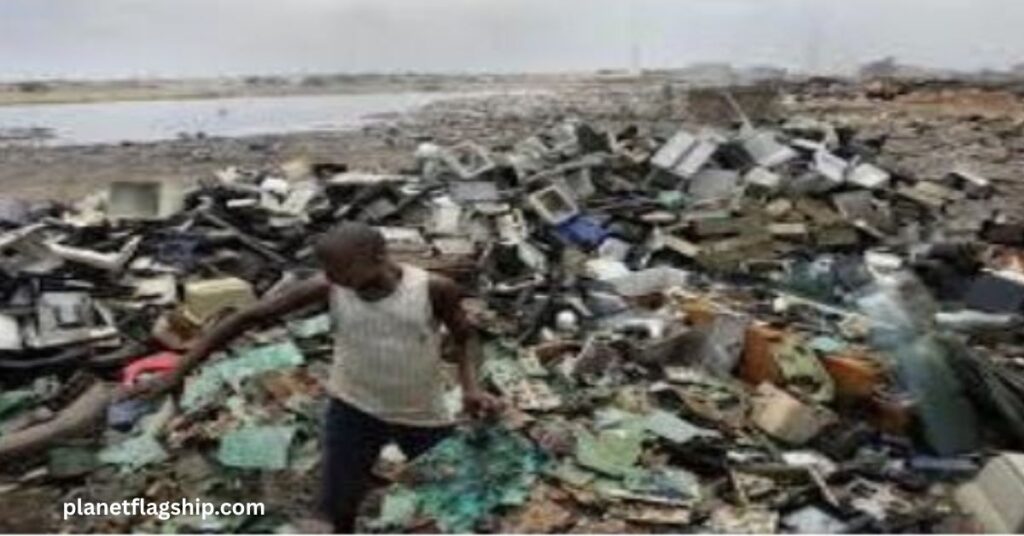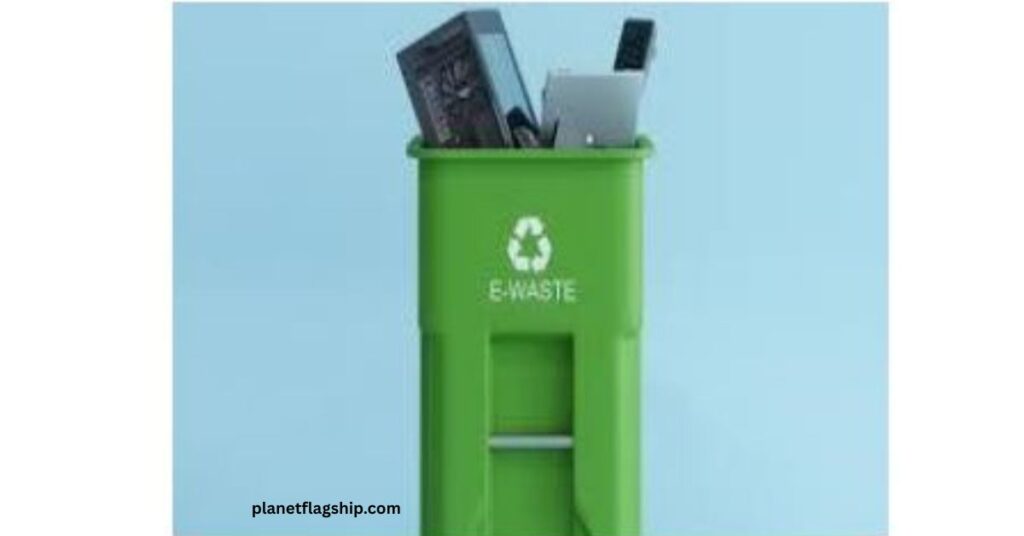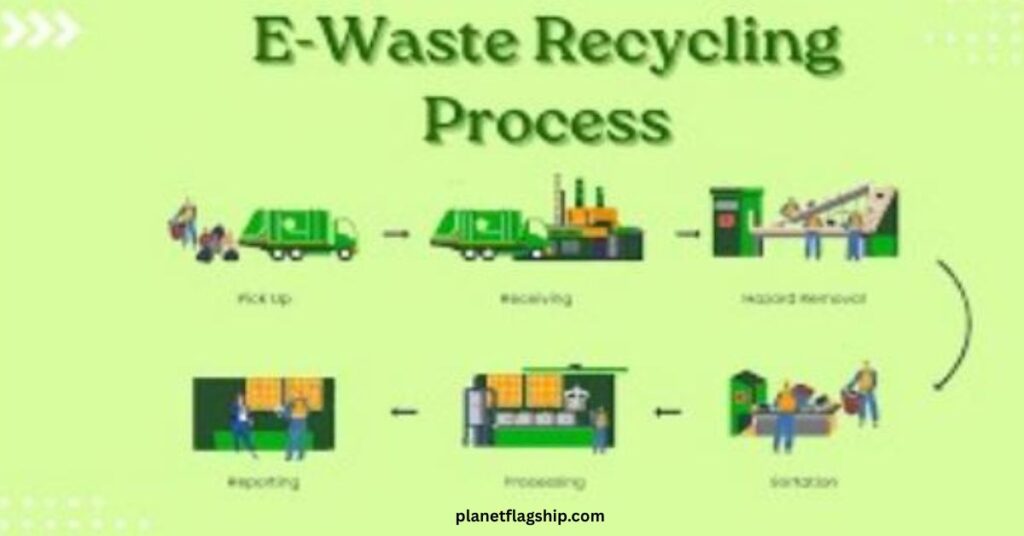Not far beneath the gleaming facades of Silicon Valley and our everyday smartphones lies a significant issue. As we continue to develop, the environmental cost of using such products is often overlooked. E-Waste Dumping is recognized as one of the fastest-growing waste types worldwide, posing serious threats to both ecosystems and public well-being. This article discusses the environmental inequities created by e-waste disposal, the loopholes in regulatory oversight, and suggests ways to address the growing challenge.
The Scale of the Problem
Internationally, there are approximately 50 million metric tons of electronic waste made every year. The Global E-waste Monitor expects global e-waste generation to exceed 74 million tons by 2030. Officially reported to be responsibly treated for collection and recycling, only about 17.4% of the electronic waste is reported, meaning that the rest are facing the risk of improper disposal or unregulated processing. The amount of e-waste produced annually in the United States is estimated at 6.9 million tons, equivalent to about 46 pounds of e-waste per person per year. Having the highest amount of electronic waste in the world, the US has weak federal regulations for managing e-waste.
Due to regulatory gaps and the high cost of domestic recycling, exporting e-waste to developing nations becomes economically viable. Although the European Union boasts of strong regulation of the WEEE directive, issues of implementation remain massive barriers. While superior tracking systems are available, most of Europe’s e-waste continues to evade official controls and ends up in developing countries, despite legal restrictions.
The Toxic Journey of E-Waste
Many people believe that after their old gadgets are discarded, their electronics will be properly recycled within their country. The reality is far different. Large amounts of electronic waste from richer countries find their way to countries like Ghana, Nigeria, Pakistan, Vietnam, and China, where environmental regulations are less stringent and labor is cheaper.
The “e-waste capital of the world,” Guiyu, is perhaps a frightening example of the effects of the e-waste trade. Guiyu used to receive regularly used electronics from Western countries for decades. These workers – most of them children – broke down the waste, using simple, horrendous methods to recover metals, plunging circuit boards into acid, and grinding up screens containing potentially lethal chemicals. As far as the world is concerned, the suburb of Accra, Ghana, which is known as Agbogbloshie, is also well known for being one of the major e-waste grounds in Africa.
Many of the workers involved cut down cables in open fires to recover copper, which emits toxins into the atmosphere and pollutes soil and nearby bodies of water. In some of these regions, even at the age of six, children are made to work in hazardous electronics recycling to help meet their families’ financial needs.
READ MORE: Climate Resilient Housing: How Homes of the Future Will Look
Case Studies: Agbogbloshie and Guiyu
Agbogbloshie, Ghana: Not far from Accra, Agbogbloshie was once known as the world’s largest site for junk electronics. Many workers carried out salvaging metals, and open burning was the norm for this process.
A lot of pollution and serious health problems arose among people living there. Although efforts to clean up have begun, the country’s economy remains heavily reliant on e-waste exports, making it challenging to implement sustainable options.
Guiyu, China: Guiyu was well known for becoming the center of a huge, unofficial recycling of electronic waste. It was common for over 60,000 people to be hired to take apart electronics with methods like acid baths, threatening their safety. The result was catastrophic pollution: polluted rivers, dirty air, and toxic soil in farms. Afterward, Chinese officials relocated the factory to a park with improved standards, but environmental issues are taking a long time to resolve.
The Toxic Legacy

The variety of dangerous materials in electronic devices includes lead, mercury, cadmium, beryllium, brominated flame retardants, and polyvinyl chloride (PVC). When improperly handled:
- Lead that gets out from the circuit boards and monitors can damage the nervous system and cause trouble with children’s development. Mercury contained in flat screens can impair brain and kidney function and affect the development of the fetus.
- Cadmium, found in rechargeable batteries, can damage the kidneys and conditions that affect bone health.
- Brominated flame retardants used in electrical equipment may disrupt endocrine systems and block the development of the human brain in children.
- Hexavalent chromium, common in electronic housing materials, is a powerful carcinogen associated with respiratory disorders and DNA damage.
Studies in specialized areas of e-waste treatment indicate severe health effects. Residents of Guiyu have increased levels of lead in their blood, and children living within an e-waste site are exposed to increased incidences of congenital disabilities, developmental problems, and loss of cognitive ability.
Scientists in Ghana have reported increased levels of carcinogens in breast milk samples from women living near Agbogbloshie. Besides harming human health, improper e-waste disposal damages the broader environment. Toxic materials seep into the soil and aquifers, leading to contamination of both soil and drinking water.
Burning plastic parts emits dioxin and furan gas, substances that science ranks amongst the most toxic in the environment. Mismanaged disposal of discarded electronics causes continuous environmental damage, which requires significant and long-term intervention to compensate.
The Economics of E-Waste

Profitability is the reason why the e-waste trade remains a flourishing industry. Several economic pressures propel this environmentally dangerous industry:
- High Recycling Costs: Environmental and labor regulations in advanced countries make legitimate e-waste recycling too expensive.
Shifting electronics to areas with poor environmental controls is a significant cost-saving proposition. There is often a huge difference in costs: a computer that can be recycled in the US could go for some $20, and shipping it off to a developing country may cost less than a fraction of the fee.
- Valuable Materials: Electronic waste contains valuable metals such as gold, silver, copper ore, and rare earth elements. A ton of circuit boards contains 40-800 times the amount of gold found in mined gold ore. In poor countries with limited resources, the removal of valuable metals from e-waste is often more profitable than assessing the health risks.
- Regulatory Arbitrage: Global companies are prone to limiting searches for territories with less strict environmental standards and thereby shifting the guilt of hazardous waste to countries that have no power to regulate it.
The financial value of e-waste is substantial. The estimated annual value of raw materials in global e-waste exceeds $62.5 billion, surpassing the GDP of many countries that receive this e-waste. The idea of e-waste as a valuable commodity and hazardous waste complicates the problems inherent in managing this waste responsibly.
Regulatory Failures
The Basel Convention on the Control of Transboundary Movements of Hazardous Wastes and Their Disposal constitutes the foundation of international policy concerning the shipment of electronic wastes. This treaty, entered into in 1989, outright prohibits the export of this waste form from developed nations to developing ones, unless allowed. The adoption notwithstanding, the Basel Convention faces great difficulties in implementing its provisions:
- Enforcement Challenges: The lack of customs resources and difficulties in distinguishing genuine waste from useful products provide an opportunity for illegal shipments to continue. The absence of advanced monitoring technology discourages efficient port surveillance in most developing countries.
- Loopholes: Some exporters falsify that e-waste is “used goods” or “donations”, avoiding the stringent provisions regarding hazardous materials. Functional electronics tend to slip through the regulatory cracks and can, therefore, be exported as non-hazardous goods.
- Non-Participation: With 187 countries forming part of the Basel Convention, the US is alone as a non-party, leaving the free export of American e-waste almost impossible.
- Limited Domestic Legislation: The lack of appropriate legislation for e-waste in developing countries has contributed to gaps in enforcement, allowing improper exporting operations.
Towards Sustainable Solutions

- Extended Producer Responsibility (EPR)
Require technological companies to handle the recycling of their products. Incentivize eco-design and take-back programs.
- Formal Recycling Infrastructure
Choose recycling plants that are certified and have proper safety and environmental rules. Provide training for workers on the safe processing of e-waste.
- Global Regulation and Enforcement: Governments should enhance the Basel Convention to effectively curb the illegal shipping of electronics. Strictly track the movements of e-waste from one country to another.
- Consumer Awareness & Action
Ensure that people understand the importance of effective garbage management. Carton gently suggests people donate, fix, or recycle their electronics, rather than throwing them away.
- Incentives for Eco-Friendly Products
Back devices that can be easily fixed, improved, and recycled. Make it easier for eco-friendly companies to pay less tax.
- Urban Mining and Material Recovery
Utilizing e-waste to recover metals can help reduce the need for raw mining.
READ MORE: Using Artificial Intelligence to Fight Wildlife Poaching: A Leading Edge in Conservation
FAQs on E-Waste Dumping: The Dark Side of the Tech Industry
What is e-waste and why is it a growing problem?
E-waste, or electronic waste, includes discarded electronic devices like phones, laptops, and TVs. It’s one of the fastest-growing waste streams in the world, expected to exceed 74 million tons by 2030. Most e-waste isn’t properly recycled, leading to severe pollution, toxic exposure, and health risks in developing countries where it’s often dumped.
why is e-waste exported to developing countries?
Exporting e-waste is cheaper for developed nations. Recycling electronics domestically is costly due to strict environmental and labor regulations, so companies ship waste to countries with weaker enforcement. Unfortunately, this shifts the toxic burden onto poor communities with limited protection.
What are the health risks associated with e-waste exposure?
E-waste contains hazardous substances such as lead, mercury, cadmium, and brominated flame retardants. Exposure can cause neurological disorders, kidney damage, respiratory problems, and developmental issues in children. In places like Guiyu and Agbogbloshie, workers face severe long-term health consequences.
How can e-waste management become more sustainable?
Sustainability begins with Extended Producer Responsibility (EPR), which holds manufacturers accountable for recycling their products. Building formal recycling facilities, enforcing global trade regulations, and promoting repairable, recyclable product designs can all reduce environmental harm.
What can consumers do to help reduce e-waste?
Consumers can make a difference by repairing rather than replacing electronics, recycling old devices through certified programs, and supporting brands committed to eco-friendly production. Donating functional electronics and buying second-hand items also help reduce the global e-waste footprint.
Conclusion
Our digital age has left us with e-waste, which is poisoning the country and harming people, particularly in developing countries. What supports us in our everyday lives can become detrimental to society and the environment when discarded.

John is a professional blogger and passionate advocate for environmental sustainability. With years of experience exploring eco-friendly practices and green innovations, he shares insightful articles on Planet Flagship to inspire a sustainable future. John’s expertise lies in making complex environmental topics accessible and actionable, empowering readers to make meaningful changes for the planet.
